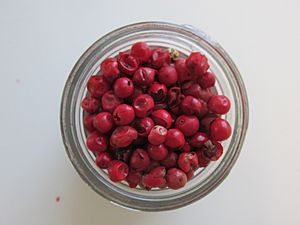Pink peppercorn facts for kids

Pink peppercorns
|
|
| Alternative names | Baie rose |
|---|---|
| Type | Dried berry |
A pink peppercorn is a dried berry that looks a lot like a regular peppercorn. Even though it's called a "peppercorn," it doesn't come from the same plant as black pepper. In French, it's known as baie rose, which means "pink berry."
Pink peppercorns are used as a spice in cooking. They have a unique taste that is a little bit spicy and slightly sweet.
Contents
Different Kinds of Pink Peppercorns
When people talk about pink peppercorns, they might be talking about berries from three different plants. Each one is a bit different.
The Baies Rose Plant
One type of pink peppercorn comes from the Euonymus phellomanus plant, often called the Baies rose plant. These berries are usually brought in from Madagascar. Because they travel so far, they can be quite expensive. They have a strong, slightly sweet taste, but they are not as strong as true black pepper.
Peruvian Peppertree Berries
Another kind of pink peppercorn comes from the Schinus molle tree, also known as the Peruvian peppertree. These berries are often mixed with regular black pepper. They are called pink peppercorns because they look like pepper and have a peppery flavor.
Important Allergy Information
The Peruvian peppertree is part of the cashew family. This means that if you have a tree nut allergy, especially to cashews, you might have an allergic reaction to these pink peppercorns. Reactions can be serious, so it's important to be careful if you have nut allergies.
Brazilian Pepper Berries
The third type of pink peppercorn comes from the Schinus terebinthifolia tree, known as the Brazilian pepper. These berries are also used as a spice. The Brazilian pepper tree was brought to Florida a long time ago as a decorative plant. Since then, it has spread very quickly and is now considered an invasive plant in some areas.
Are Pink Peppercorns Safe to Eat?
For a while, there were some questions about whether pink peppercorns were safe to eat.
Past Concerns and Safety
In 1982, the Food and Drug Administration (FDA) in the United States stopped Brazilian peppercorns from being brought in from France. They were worried that eating the berries could cause problems like swollen eyelids or an upset stomach. However, the French government said that the berries were safe if grown correctly. Later, the United States removed the ban.
Today, pink peppercorns are generally considered safe for people to eat. However, the berries and leaves from the Peruvian and Brazilian pepper trees can be harmful to some animals, like chickens and pigs. There have also been reports of young children getting sick with vomiting or diarrhea after eating the fruit. Because of these past concerns, these specific types of pink peppercorns do not have a special "generally recognized as safe" (GRAS) status from the FDA.

